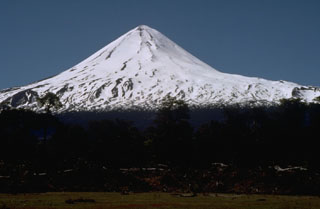Report on Llaima (Chile) — 2 January-8 January 2008
Smithsonian Institution / US Geological Survey
Weekly Volcanic Activity Report, 2 January-8 January 2008
Managing Editor: Sally Sennert.
Please cite this report as:
Global Volcanism Program, 2008. Report on Llaima (Chile) (Sennert, S, ed.). Weekly Volcanic Activity Report, 2 January-8 January 2008. Smithsonian Institution and US Geological Survey.
Llaima
Chile
38.692°S, 71.729°W; summit elev. 3125 m
All times are local (unless otherwise noted)
SERNAGEOMIN reported that seismic tremor coincided with the onset of gas emissions and the ejection of pyroclastic material from Llaima on 1 January. Within a few hours, a Strombolian phase began. An increase in volume of the Captrén River on the N flank was observed. On 2 January, small emissions of ash and gas (mainly steam) and three small lahars on the N and W flanks were observed during an overflight. Tremor also decreased and an explosion was observed. Based on pilot reports and observations of satellite imagery, the Buenos Aires VAAC reported that an ash plume rose to an unconfirmed altitude of 12.5 km (41,000 ft) a.s.l. and drifted E on 2 January. A lava flow on the E flank was also noted.
On 3 January, another overflight revealed that the explosion that occurred on the previous day took place from an area high on the E flank and not from within the crater. Emissions of gas and ash were small and sporadic. The Buenos Aires VAAC reported that an ash plume was visible on satellite imagery at an altitude of 3.7 km (12,000 ft) a.s.l. and drifted NE.
Geological Summary. Llaima, one of Chile's largest and most active volcanoes, contains two main historically active craters, one at the summit and the other, Pichillaima, to the SE. The massive, dominantly basaltic-to-andesitic, stratovolcano has a volume of 400 km3. A Holocene edifice built primarily of accumulated lava flows was constructed over an 8-km-wide caldera that formed about 13,200 years ago, following the eruption of the 24 km3 Curacautín Ignimbrite. More than 40 scoria cones dot the volcano's flanks. Following the end of an explosive stage about 7200 years ago, construction of the present edifice began, characterized by Strombolian, Hawaiian, and infrequent subplinian eruptions. Frequent moderate explosive eruptions with occasional lava flows have been recorded since the 17th century.
Sources: Buenos Aires Volcanic Ash Advisory Center (VAAC), Servicio Nacional de Geología y Minería (SERNAGEOMIN)

